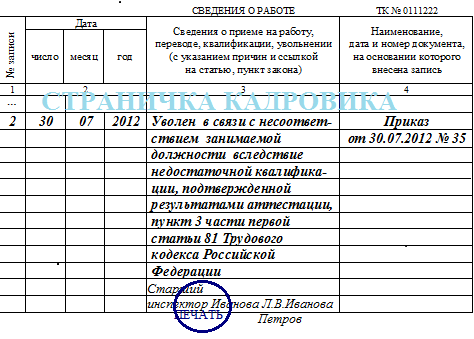The work book is one of the key documents that reinforce legal facts that relate to legal relations between the employer and the employee. Therefore, human resources workers should approach with particular responsibility to fill out this document, as well as to make adjustments to it. What nuances regarding these actions should I pay attention to?
Job Records
Let us consider how to make an entry in the work book if the inspector of the OK is faced with the task of entering data on the work into the corresponding document. What is the specifics of working with a book in this aspect? What are the requirements of legislative regulations related to solving such problems?
One of the common discussion points related to entering information into the corresponding section of the work book concerns whether to include in the document a phrase reflecting the fact that a person had no seniority before entering work. Many personnel officers practice this action. But the legislation does not require this. Therefore, when applying for a job for a person for whom joining the company is the first experience, we will not record information reflecting this fact in the corresponding document.

Inserting the necessary information into the section of the document under consideration, the HR specialist in all cases is obliged to record data on the employee’s qualifications - these are the requirements of the rules governing how entries are made in the workbook. For example, it may be such wordings: "Accepted into such a workshop by a milling machine of such and such a category."
Another major nuance regarding the procedure for entering information in the section on the work of the workbook: it is not necessary to certify the relevant information with the organization’s seal and the signature of the head or other authorized employee. The fact is that the details that certify the information in the workbook, namely the signature and seal, should be affixed in the document only when the employee leaves.
Part-time job
Noteworthy are the facts regarding such a legal category as multiple jobs. An entry in the work book, stating that the employee and the employer interact within the framework of the appropriate type of legal relationship, should be made subject to a number of nuances. Consider them.
It is useful to note that regarding such a phenomenon as part-time employment, entries in the work book can be made only if the employee himself wishes it. The relevant information is recorded in a document by the personnel department at the main place of work of the person on the basis of documents confirming the fact that the employee is still working somewhere - usually this is a properly executed certificate from another employer.

An interesting nuance: even if a person quit his job part-time, he can nevertheless reflect in the work book that he was engaged in relevant activities in another company. The personnel specialist of the main employer company is not entitled to refuse to fix the information in question for the employee.
How to enter data on part-time employment, provided that the person has already quit the additional job? Very simple.In the 1st column of the document the date of the employee’s hiring at another enterprise is indicated, in the 2nd column information about his acceptance to the staff of the relevant organization is recorded, in the 4th column information about the document, which is the basis for making entries in the workbook. Similarly, a record is recorded in the work book reflecting the fact of the dismissal of a person from an additional job.
Transfer
When a person is transferred from one organization to another, should this be reflected in the workbook? Yes, it is necessary. As soon as the translation is completed, an entry in the work book certifying this procedure should be made. However, in practice, solving this problem may be accompanied by certain difficulties. What are they connected with?
Among the common discussion points is the situation in which there should be an entry in the work book reflecting the fact that a person was transferred to another job temporarily. But then he took shape there on an ongoing basis due to the fact that the previous vacancy was abolished, and the employee decided to continue working in a new place. A similar scenario is reflected in article 722 of the Labor Code of the Russian Federation.
The specificity of such cases is that information about temporary transfers from one work to another cannot be entered into the workbook. Only if a person subsequently takes shape at a new place constantly, the corresponding entry in the work book can be made. In this case, the date of entry must correspond to the moment of legally fixed transfer of an employee to a permanent vacancy. The legislative sources that would regulate the introduction of such data do not contain examples of the necessary wording.
But how, after all, are such records made in labor books? An example of a scheme for entering such information may be as follows. The second column of the document indicates the date reflecting the fact that a transfer entry was made in the workbook (as soon as the employer issues an order confirming that the person begins to perform his functions on an ongoing basis). In the 3rd column, a record reflecting the transfer is recorded, but the date of the actual start of a person’s labor activity at a new place of work is also indicated. The 4th column contains data on two orders: on which a person transferred to a new company, and on which he began to work on an ongoing basis.
Workbook fixes
What criteria should be used by a personnel officer if he is faced with the task of correcting an entry in the workbook? The practical significance of such actions arises in cases where the specialist needs to correct inaccurate or inaccurate information. Most often this applies to sections containing information about the work, as well as employee awards. In accordance with current regulations, it is impossible to cross out incorrect data in workbooks. They should be completely rewritten - as amended. This procedure is characterized by a number of nuances.
First of all, a record containing errors should not only be rewritten, but should be supplemented with an appropriate explanation: why does the HR specialist carry out this procedure. As a rule, it is enough to limit oneself to a comment reflecting the fact that a record assigned to such and such a number is recognized as invalid. Then, correct information is entered into the workbook with reference to documents that certify the legality of indicating new information.
Dismissal
One of the most difficult procedures, reflecting the legal relationship with the participation of the employee and the employer, is dismissal. Record in the work book, which records the dismissal of a person from his post, can be made on different grounds. Let's consider some of them.
Standard scenario - when an employee leaves in accordance with clause 3 77 articles of the Labor Code of the Russian Federation, that is, of their own free will.The main discussion point regarding him is what wording to enter, fixing the dismissal. The entry in the work book, which was made by a specialist in the personnel department of one enterprise, may not be similar to the wording of colleagues from other firms.

For example, some personnel officers may write that a person was dismissed in accordance with paragraph 3 of Article 77 of the Labor Code of the Russian Federation, while others record that the employment contract is terminated in accordance with this provision of the law. How right?
Experts note that both formulations are acceptable. It all depends on what specific legislative act guides the personnel officer. There are two basic documents regulating how entries should be made in the workbook upon dismissal. The first is the Decree of the Ministry of Labor No. 69, published on 10.10.2003. In accordance with it, a note is made in the work book stating that the person has been dismissed. Another source of law is the TC itself, namely Article 84.1. According to its provisions, the personnel officer has the right to enter into the workbook a wording reflecting not termination of an employee, but termination of the contract on the appropriate basis.
A variant is possible in which an employee initiates his dismissal for reasons involving some benefits and preferences established by law. For example, it may be necessary to quit work due to the fact that a person needs to care for a child.
Another scenario is dismissal, which involves the transfer of an employee from one company to another. There can be several reasons for this in the legislation: translation at the personal request of the employee and at the initiative of the employer, but with the consent of a specialist. These are the provisions of paragraph 5 of Article 77 of the Labor Code of the Russian Federation. The choice of a specific wording determines what entries in the work book will be made.
The most important nuance to which attention should be paid to specialists of personnel departments of enterprises when working with workbooks during dismissal is as follows: it is impossible to refer to Article 80 of the Labor Code of the Russian Federation when determining the legal basis for terminating legal relations with an employee. It cannot be a reason for dismissal - it only contains provisions that clarify in what order the contract should be terminated if the employee leaves at his own request.
Is it permissible to correct errors in the title page?
Another problematic aspect common in the practice of the work of Russian personnel officers is corrections in the title page of the workbook. What should specialists pay attention to? Is it permissible to make corrections to the work book if it is a question of adjusting the information on its cover page?
An interesting fact is that in the current sources of law there are no provisions that would officially regulate how the personnel officer should correct erroneous data in the corresponding part of the form. Therefore, many lawyers tend to believe that the title page of a document is not subject to adjustment. You must immediately make the correct entries in the work book, in this element. If the person filling out the document is mistaken, then such is considered invalid.
But there is another point of view. In accordance with it, making an entry in the workbook in order to adjust its title page is permissible, since this is not prohibited by law. Changes will be recorded in accordance with the same standards that are set to work with sections of the document that contain the name of the employee. That is, you need to cross out the wrong information and enter the correct. On the other hand, if we take into account that this kind of information is introduced during the initial filling of the form, it would be much easier (and more correct) to draw up a new document.
Where to get the print on the cover page?
Consider another interesting aspect of working with work books regarding the design of the title page of a document.According to the legislation governing the work with this kind of documentation, the corresponding section must contain the seal of the organization that first issued the book for the person. In the practice of labor relations, there are cases when the company for some reason does not affix the appropriate props. Should the document be considered invalid in such cases? No, he does not lose his legal force. However, it must be brought into line with the criteria prescribed by law.
In the general case, the previous employer company, as noted by lawyers, should assist a person in ensuring the correctness of filling out the main labor document and still stamp it. But it is possible that the company has already been liquidated. And in this case, the employee can take the following steps. 
First, he can go to the archive in order to request documents there that will help him prove that he worked in a particular organization. Secondly, a person can apply to the court by drawing up a statement, according to which the fact of his labor activity in the company should be established.
The personnel officer of the new company, having received documents that the employee managed to get through the indicated methods, can put a seal on the title page. But with this the company confirms the fact that the information entered in the work book by the previous employer can be considered correct.
Who can correct the entries?
In the general case, the personnel book should only be amended by a specialist in the personnel department of only the employer company that allowed the incorrect information to be recorded in the employee’s document. But a scenario is possible in which another employer also has the right to correct the information in the work book. To do this, a document must be put at the disposal of the personnel officer of the company, which will be considered the official basis for making changes. This may be a copy of the order on hiring an employee, as well as on his dismissal.
Change in company status
Another common case: an employer company is being reorganized. For example, it could be its takeover by a larger firm. As a result, employees of the company, which became part of another structure, begin to work for another legal entity. Is there a need to update the entry in the workbook in this case? The posts may remain the same, is there any legal sense in the implementation of the relevant adjustments? 
In the 75th article of the Labor Code of the Russian Federation it is said that a change of ownership of the property of a company cannot serve as a basis for canceling labor contracts. Exceptions are set only for top managers of the company. The management of the organization, its deputies, as well as the chief accountant in some cases are obliged to draw up new employment contracts. Accordingly, the information in their workbooks should be updated.
Filling workbooks with entrepreneurs
As you know, entrepreneurs, as well as legal entities, are obliged to keep work books for employees. What are the features of filling out this document by entrepreneurs? There are few fundamental differences between the procedures specific to working with the documentation of legal entities and individual entrepreneurs. Legislation governing how a personnel officer can make an entry in the work book should be interpreted by legal entities and individual entrepreneurs alike. But there are still some nuances that reflect the specifics of working with a document in organizations operating in the status of individual entrepreneurs.
Entries made in the relevant document, while the employee is engaged in labor activities in the organization, must be certified by the signature of the employer or a competent HR specialist. If an individual entrepreneur hired a personnel officer or secretary who is responsible for maintaining work books, then there are no problems: he fills in the forms and puts the necessary details on them by a hired specialist.

But what if the individual entrepreneur chose not to hire assistants and conducts work books independently? An entrepreneur de jure is not an employee of his own company. As for the LLC, there is usually no problem with this: even if the personnel officer is not accepted into the staff, his functions can be performed by the head - he has every right to work with such a document as a work book. The director can make an entry, correct, add, that is, make any necessary actions with the document.
IP, of course, can take shape as a leader, despite the fact that this is unprofitable (due to the need to pay personal income tax and contributions to funds). But the legislator is quite liberal regarding the aspect of working with workbooks: IE can fully have the status of “employer”, which is directly provided for by the Labor Code of the Russian Federation. How, in this case, should be made entries in work books? A sample of the appropriate fill pattern for an IP can be this. Suppose we are hiring a person. In the 2nd column we write the date of execution of the relevant order (IP should also publish it). Next, we make an entry in the work book reflecting information about where the person came to work and what position - information is entered in the 3rd column. We write in full: "Individual Entrepreneur Ivanov Peter Sidorovich." We fix below that a person is “accepted to the position of such and such”. In the 4th column we indicate on the basis of what order the person is credited to the organization’s staff. OGRNIP and other details identifying the entrepreneur, it is not necessary to enter in this section of the work book.








